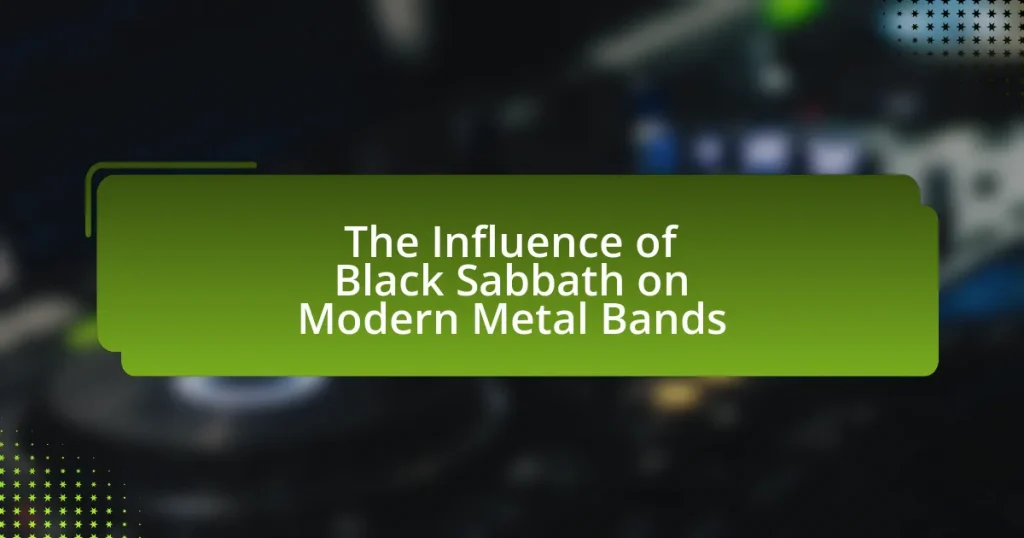The article focuses on the role of subgenres in defining metal band identities, highlighting how distinct categories within the metal genre, such as thrash, death, black, and power metal, shape musical styles, lyrical themes, and visual aesthetics. It examines how these subgenres influence a band’s identity, audience engagement, and branding, as well as the challenges bands face in navigating audience expectations and market saturation. Additionally, the article discusses the importance of subgenre diversity in fostering collaboration among bands and enhancing the overall cultural significance of the metal community. Key characteristics of various subgenres and their impact on a band’s sound and marketing strategies are also explored.

What are Subgenres in Metal Music?
Subgenres in metal music are distinct categories that emerge from the broader metal genre, characterized by unique musical styles, themes, and cultural influences. These subgenres, such as thrash metal, death metal, black metal, and power metal, each possess specific traits that differentiate them from one another, including variations in tempo, instrumentation, and lyrical content. For instance, thrash metal is known for its fast tempos and aggressive guitar riffs, while doom metal is characterized by slower tempos and a heavier, more melancholic sound. The existence of these subgenres allows metal bands to cultivate unique identities and connect with specific audiences, thereby shaping the overall landscape of metal music.
How do subgenres influence the identity of metal bands?
Subgenres significantly influence the identity of metal bands by shaping their musical style, lyrical themes, and visual aesthetics. Each subgenre, such as thrash, death, or black metal, carries distinct characteristics that inform how bands express their artistic vision. For instance, thrash metal is known for its fast tempos and aggressive riffs, which can lead bands to adopt a more energetic and rebellious image. In contrast, doom metal often emphasizes slower tempos and melancholic themes, resulting in a darker, more introspective identity.
Moreover, the subgenre a band aligns with can affect its fanbase and community engagement. Bands that identify with specific subgenres often participate in niche festivals and collaborate with like-minded artists, reinforcing their identity within that subculture. This connection is evident in the way bands like Metallica (thrash) and My Dying Bride (doom) have cultivated distinct identities that resonate with their respective audiences. Thus, subgenres not only define the sound of metal bands but also play a crucial role in shaping their overall identity and cultural significance within the metal community.
What are the key characteristics of different metal subgenres?
Different metal subgenres exhibit distinct characteristics that define their sound, themes, and cultural identity. For instance, heavy metal is characterized by its powerful guitar riffs, strong rhythms, and themes of rebellion, often influenced by early bands like Black Sabbath. Thrash metal, exemplified by bands such as Metallica and Slayer, features faster tempos, aggressive guitar work, and socially conscious lyrics.
Death metal is known for its growled vocals, complex song structures, and dark themes, with bands like Cannibal Corpse leading the genre. Black metal, represented by acts like Mayhem and Burzum, emphasizes atmospheric elements, high-pitched shrieking vocals, and often incorporates themes of nature and mythology.
Doom metal, with bands such as Candlemass, is characterized by slow tempos, heavy riffs, and themes of despair and melancholy. Power metal, represented by bands like Helloween, focuses on melodic instrumentation, fantasy-themed lyrics, and anthemic choruses.
Each subgenre not only shapes the musical style but also influences the identity and branding of the bands within the metal community, creating a diverse landscape that reflects various cultural and thematic elements.
How do subgenres shape the musical style of a band?
Subgenres shape the musical style of a band by influencing their sound, lyrical themes, and overall aesthetic. For instance, a band categorized as death metal typically incorporates heavy guitar riffs, growled vocals, and complex song structures, which are characteristic of that subgenre. In contrast, a band identified as power metal often features melodic guitar solos, clean vocals, and fantasy-themed lyrics. This differentiation is evident in bands like Cannibal Corpse, known for their brutal sound and graphic lyrics, versus Blind Guardian, which emphasizes storytelling and orchestration. The specific elements of each subgenre guide the band’s creative choices, ultimately defining their identity within the broader metal genre.
Why are subgenres important for metal fans?
Subgenres are important for metal fans because they provide a framework for identifying and categorizing the diverse styles within the metal genre. This categorization allows fans to discover music that aligns with their specific tastes, as each subgenre, such as thrash, doom, or black metal, has distinct characteristics and themes. For instance, thrash metal is known for its fast tempos and aggressive riffs, while doom metal is characterized by slower tempos and a heavier, more melancholic sound. This diversity enriches the listening experience and fosters a sense of community among fans who share similar preferences, ultimately enhancing their engagement with the metal scene.
How do subgenres help fans identify with specific bands?
Subgenres help fans identify with specific bands by categorizing music into distinct styles that resonate with their personal tastes and values. For instance, fans of death metal may be drawn to bands like Cannibal Corpse due to the genre’s aggressive sound and thematic content, which reflects a preference for intensity and complexity in music. This categorization allows fans to find communities and connect with others who share similar musical preferences, enhancing their overall experience and loyalty to the band. Additionally, subgenres often come with specific cultural and aesthetic elements, such as fashion and ideology, further solidifying the bond between fans and their chosen bands.
What role do subgenres play in the metal community?
Subgenres play a crucial role in the metal community by allowing bands to define their unique identities and connect with specific audiences. Each subgenre, such as thrash, death, or black metal, encompasses distinct musical characteristics, themes, and cultural elements that resonate with fans. This diversity fosters a rich tapestry of creativity and expression within the metal genre, enabling bands to explore various lyrical and musical styles while attracting dedicated fan bases. For instance, the emergence of subgenres has led to the establishment of festivals and communities that cater to specific styles, further solidifying the identities of bands and their followers within the broader metal scene.

How do Subgenres Define Metal Band Identities?
Subgenres define metal band identities by categorizing their musical style, lyrical themes, and aesthetic elements, which collectively shape how they are perceived within the metal community. For instance, bands classified as death metal often emphasize aggressive instrumentation and dark, violent lyrics, while those in the power metal subgenre typically focus on melodic elements and fantastical themes. This classification not only influences the band’s sound but also attracts specific audiences, creating a sense of belonging among fans. Additionally, the distinct characteristics of each subgenre, such as the use of growled vocals in black metal or the incorporation of orchestral elements in symphonic metal, further solidify a band’s identity and differentiate them from others within the broader metal genre.
What factors contribute to a band’s subgenre classification?
A band’s subgenre classification is primarily influenced by musical elements, lyrical themes, and cultural context. Musical elements include instrumentation, tempo, and song structure, which can distinctly categorize a band within a specific subgenre, such as thrash metal or doom metal. Lyrical themes often reflect the band’s identity and can align with subgenres like black metal, which frequently explores dark or mystical subjects. Cultural context, including the band’s geographical origin and the influences of local music scenes, also plays a significant role in shaping subgenre classification, as seen in the emergence of Scandinavian black metal or American metalcore. These factors collectively determine how a band is perceived within the broader metal genre.
How do lyrical themes influence a band’s subgenre identity?
Lyrical themes significantly shape a band’s subgenre identity by aligning the band’s message and aesthetic with specific cultural and musical contexts. For instance, bands that explore themes of darkness, mythology, and existentialism often align with subgenres like black metal or doom metal, which emphasize these motifs in their sound and imagery. Conversely, bands that focus on social issues, personal struggles, or political commentary may identify more with subgenres such as metalcore or thrash metal, which often incorporate these themes into their lyrical content. This alignment is evident in the works of bands like Slayer, whose lyrics often address violence and societal issues, solidifying their place in thrash metal, while bands like Opeth, with their themes of nature and introspection, are categorized within progressive metal. Thus, lyrical themes serve as a crucial element in defining a band’s subgenre identity by creating a cohesive narrative that resonates with the audience and reflects the musical style.
What role does instrumentation play in defining a band’s subgenre?
Instrumentation is crucial in defining a band’s subgenre, as it directly influences the sound, style, and overall identity of the music. For example, the use of distorted electric guitars, aggressive drumming, and growled vocals characterizes death metal, while clean vocals and melodic guitar lines are typical in power metal. Specific instruments and their arrangements create distinct auditory experiences that align with particular subgenres, such as the incorporation of orchestral elements in symphonic metal or the use of traditional folk instruments in folk metal. These instrumental choices not only shape the musical texture but also signal to listeners the subgenre’s conventions and cultural associations, thereby solidifying the band’s identity within the broader metal genre.
How do subgenres affect a band’s branding and image?
Subgenres significantly influence a band’s branding and image by shaping audience expectations and defining the band’s musical identity. For instance, a band categorized as death metal will adopt a darker aesthetic and lyrical themes, which align with the genre’s characteristics, thereby attracting a specific fan base that resonates with those elements. This alignment is crucial, as research indicates that genre-specific branding can enhance marketability; a study by the Journal of Popular Music Studies highlights that bands that clearly define their subgenre often experience increased fan loyalty and engagement. Consequently, the subgenre not only dictates the band’s visual and thematic presentation but also plays a pivotal role in their overall market positioning within the music industry.
What visual elements are associated with different metal subgenres?
Different metal subgenres are associated with distinct visual elements that reflect their unique identities. For example, heavy metal often features dark, gothic imagery, leather jackets, and spikes, while power metal is characterized by bright colors, fantasy themes, and heroic motifs. Black metal is known for its use of corpse paint, dark clothing, and bleak landscapes, emphasizing themes of nihilism and nature. Thrash metal incorporates aggressive visuals, such as urban decay and political imagery, often using bold graphics and logos. Doom metal typically employs somber colors and imagery related to despair and darkness, often featuring slow, heavy aesthetics. These visual elements serve to reinforce the themes and attitudes of each subgenre, creating a cohesive identity for the bands and their audiences.
How do subgenres influence a band’s marketing strategies?
Subgenres significantly influence a band’s marketing strategies by shaping target audience demographics and promotional channels. For instance, a metal band identified as death metal will likely focus its marketing efforts on platforms frequented by fans of that specific subgenre, such as specialized music festivals, niche online communities, and genre-specific merchandise. This targeted approach is supported by data indicating that genre-specific marketing can increase engagement rates by up to 30%, as fans are more likely to respond to content that resonates with their musical preferences. Additionally, subgenres dictate the visual and thematic elements of marketing materials, aligning them with the expectations of the audience, which can enhance brand identity and loyalty.

What are the Implications of Subgenre Diversity in Metal?
Subgenre diversity in metal significantly influences band identities by allowing for greater artistic expression and audience segmentation. This diversity enables bands to explore various musical styles, themes, and lyrical content, which can attract different listener demographics. For instance, the emergence of subgenres like black metal, death metal, and progressive metal has led to distinct fan bases, each with unique preferences and cultural associations. According to a study published in the Journal of Popular Music Studies, the proliferation of subgenres has resulted in a more fragmented yet vibrant metal community, where bands can cultivate niche identities that resonate with specific audiences. This segmentation not only enhances the creative landscape of metal but also fosters a sense of belonging among fans, reinforcing the overall cultural significance of the genre.
How does subgenre diversity impact collaboration among bands?
Subgenre diversity enhances collaboration among bands by fostering creative exchanges and broadening musical influences. When bands from different subgenres, such as thrash metal and doom metal, collaborate, they can merge distinct elements, resulting in innovative sounds that appeal to a wider audience. This cross-pollination of ideas can lead to unique compositions and performances, as evidenced by collaborations like that of the band Metallica with various artists across genres, which has expanded their musical repertoire and fan base. Such partnerships not only enrich the artistic output but also promote a sense of community within the metal scene, encouraging bands to explore new directions and challenge traditional boundaries.
What are the benefits of cross-genre collaborations in metal?
Cross-genre collaborations in metal enhance creativity, broaden audience reach, and foster innovation. By integrating elements from various musical styles, metal bands can experiment with new sounds and techniques, leading to unique compositions that attract diverse listeners. For instance, collaborations between metal and genres like jazz or electronic music have resulted in groundbreaking albums, such as the work of bands like Opeth, which blends progressive rock and metal, showcasing the potential for artistic growth. Additionally, these collaborations can introduce metal to fans of other genres, expanding the fanbase and increasing visibility in the music industry.
How do collaborations challenge traditional subgenre boundaries?
Collaborations challenge traditional subgenre boundaries by blending distinct musical styles and influences, creating hybrid genres that defy classification. For instance, when metal bands collaborate with artists from genres like hip-hop or electronic music, they introduce elements such as rhythm patterns, instrumentation, and vocal techniques that are not typically found in traditional metal. This fusion can lead to the emergence of new subgenres, such as nu-metal, which combines metal with hip-hop influences, exemplified by bands like Linkin Park. Such collaborations not only expand the sonic palette of the participating artists but also attract diverse audiences, further blurring the lines between established subgenres.
What challenges do bands face within their subgenres?
Bands face several challenges within their subgenres, primarily including audience expectations, market saturation, and identity struggles. Audience expectations dictate that bands must adhere to specific stylistic and thematic elements to be accepted within their subgenre, which can stifle creativity. Market saturation occurs when numerous bands compete within the same subgenre, making it difficult for individual bands to stand out and gain recognition. Additionally, identity struggles arise as bands navigate the fine line between innovation and tradition, often facing pressure to conform to established norms while trying to develop a unique sound. These challenges are evident in the metal genre, where bands like Metallica and Slayer have had to balance their evolving musical styles with fan expectations and industry standards.
How can bands navigate the expectations of their subgenre audience?
Bands can navigate the expectations of their subgenre audience by understanding the specific characteristics and cultural elements that define their subgenre. This involves researching the musical style, lyrical themes, and visual aesthetics that resonate with fans of that subgenre. For instance, a band in the death metal subgenre should focus on heavy guitar riffs, growling vocals, and dark lyrical content, as these elements are crucial to meeting audience expectations. Additionally, engaging with the community through social media, attending genre-specific events, and collaborating with other bands can help bands align their identity with audience preferences. This approach is supported by the fact that bands that actively participate in their subgenre’s community often see increased fan loyalty and engagement, as evidenced by the success of bands like Cannibal Corpse and their consistent adherence to death metal conventions.
What strategies can bands use to evolve their sound while maintaining their identity?
Bands can evolve their sound while maintaining their identity by integrating diverse musical influences, experimenting with new instrumentation, and collaborating with artists from different genres. For instance, bands like Metallica incorporated orchestral elements in their album “S&M,” which allowed them to explore new soundscapes while retaining their heavy metal roots. Additionally, maintaining core lyrical themes and signature vocal styles helps preserve a band’s identity even as they innovate musically. This approach is supported by the fact that many successful bands have adapted their sound over time without alienating their fan base, demonstrating that evolution can coexist with a strong sense of identity.
What are best practices for metal bands to define their identity through subgenres?
Metal bands can define their identity through subgenres by clearly identifying their musical influences and stylistic elements. This involves selecting specific subgenres that resonate with their sound, such as thrash, doom, or black metal, and incorporating characteristic features of those styles into their music. For example, a band that identifies as a death metal group should focus on heavy guitar riffs, growled vocals, and complex song structures typical of that subgenre.
Additionally, bands should engage with the subgenre’s community by participating in relevant events, collaborating with other artists, and promoting their music through platforms that cater to that specific audience. This engagement helps solidify their identity within the subgenre and connects them with fans who appreciate those particular characteristics.
Moreover, creating a cohesive visual and thematic aesthetic that aligns with the chosen subgenre enhances their identity. For instance, a black metal band might adopt dark imagery and themes related to nature or mythology, which are hallmarks of that subgenre.
By consistently applying these practices, metal bands can effectively carve out a distinct identity that resonates with their target audience and reflects their musical vision.


